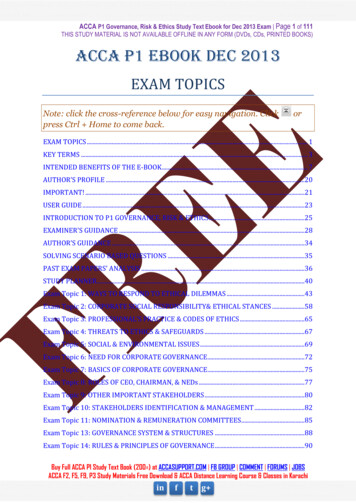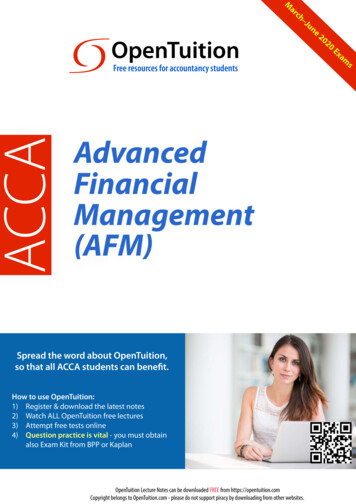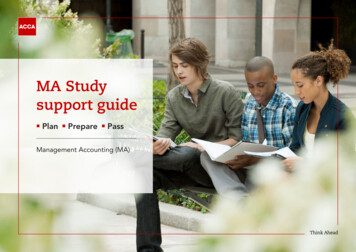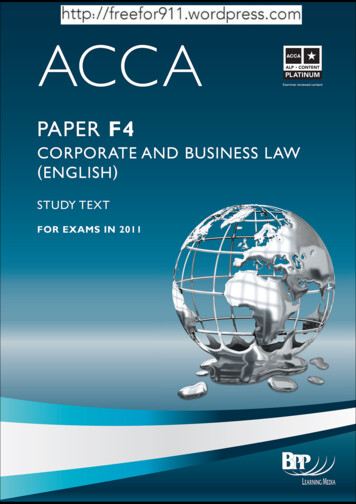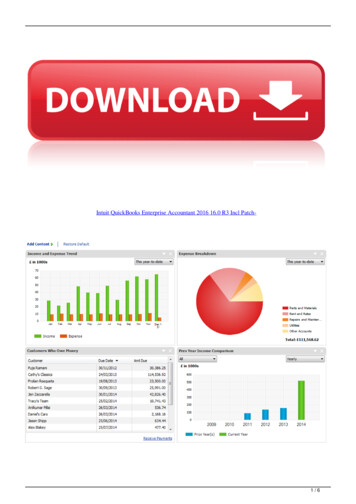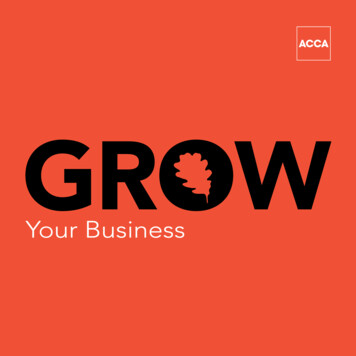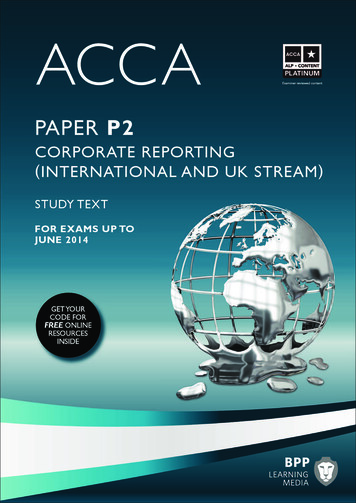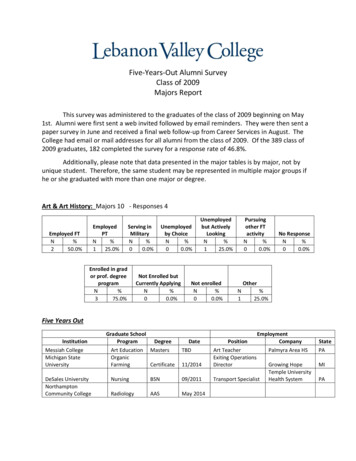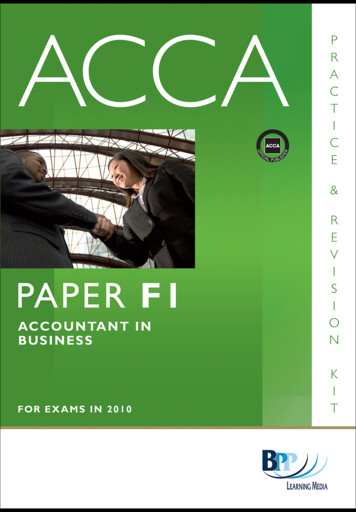
Transcription
PAPER F1ACCOUNTANT IN BUSINESSIn this January 2010 new editionxWe discuss the best strategies for revising and taking your ACCA examsxWe show you how to be well prepared for the 2010 examsxWe give you lots of great guidance on tackling questionsxWe provide you with three mock exams including the Pilot paperxWe provide the ACCA examiner's answers as well as our own to the Pilot Paper as anadditional revision aidOur i-Pass product also supports this paper.PRACTICE&REVISIONKITFOR EXAMS IN 2010
First edition 2007Fourth edition January 2010ISBN 9780 7517 8046 8(previous ISBN 9780 7517 6652 3)British Library Cataloguing-in-Publication DataA catalogue record for this bookis available from the British LibraryAll our rights reserved. No part of this publication may bereproduced, stored in a retrieval system or transmitted, inany form or by any means, electronic, mechanical,photocopying, recording or otherwise, without the priorwritten permission of BPP Learning Media Ltd.Published byBPP Learning Media LtdBPP House, Aldine PlaceLondon W12 8AAWe are grateful to the Association of Chartered CertifiedAccountants for permission to reproduce pastexamination questions. The answers to past examinationquestions have been prepared by BPP Learning MediaLtd.www.bpp.com/learningmediaPrinted in the United KingdomYour learning materials, published by BPP LearningMedia Ltd, are printed on paper sourced fromsustainable, managed forests.ii BPP Learning Media Ltd2010
ContentsPageFinding questionsQuestion index . ivUsing your BPP Learning Media Practice and Revision Kit. viPassing F1Revising F1 . viiGeneral exam support from BPP Learning Media. viiTackling multiple choice questions . viiiTackling objective test questions. ixExam information . xThe computer based examination. xQuestions and answersMultiple choice questions .3Objective test questions .35Answers to multiple choice questions .67Answers to objective test questions.89Exam practiceMock exam 1xQuestions .113xAnswers.123Mock exam 2xQuestions .131xAnswers.143Mock exam 3 (Pilot paper)xQuestions .153xAnswers.163ACCA examiner's answersxPilot paper .167Review form & free prize drawContentsiii
Question indexThe headings in this checklist/index indicate the main topics of questions. The questions in Section 1 and Section19 cover material from Chapters 1a and 1b in the Study Text.TimePage numberMarksallocationMinsQuestionAnswerMultiple choice questionsPart A: Business organisational structure,governance and management1Business organisation and structure25333672Information technology and systems15205683Influences on organisational culture19257694Ethical considerations15208705Corporate governance and social responsibility16211071Part B: Key environmental influences6The macro-economic environment233111727The business environment2331137321281574152017751723187611 Leading and managing people2027207712 Individuals, groups and teams1723217813 Motivating individuals and groups2027237914 Personal effectiveness and communication2027258015 Recruitment and selection1925268216 Diversity and equal opportunities1520288317 Training and development2027298318 Performance appraisal15203185Part C: History and role of accounting8The role of accountingPart D: Specific functions of accounting andinternal financial control9Control, security and audit10 Identifying and preventing fraudPart E: Leading and managing individuals andteamsPart F: Recruiting and developing effectiveemployeesivContents
TimePage numberMarksallocationMinsQuestionAnswer19 Business organisation and structure2128358920 Information technology and systems1520379021 Influences on organisational culture1520399222 Ethical considerations1520409323 Corporate governance and social responsibility1621429424 The macro-economic environment1723449425 The business environment152046961520479727 Control, security and audit1520499828 Identifying and preventing fraud1520519929 Leading and managing people17235210030 Individuals, groups and teams15205410131 Motivating individuals and groups15205510232 Personal effectiveness and communication17235710333 Recruitment and selection16215810434 Diversity and equal opportunities10136010635 Training and development15206110636 Performance appraisal152063107Objective test questionsPart A: Business organisational structure,government and managementPart B: Key environmental influencesPart C: History and role of accounting26 The role of accountingPart D: Specific functions of accounting andinternal financial controlPart E: Leading and managing individuals andteamsPart F: Recruiting and developing effectiveemployeesMock exam 1Paper-based examMock exam 2Computer-based examMock exam 3 (Pilot paper)Contentsv
Using your BPP Learning Media Practice and Revision KitTackling revision and the examYou can significantly improve your chances of passing by tackling revision and the exam in the right ways. Ouradvice is based on feedback from ACCA examiners.xWe focus on Paper F1; we discuss revising the syllabus, how to approach different types of question andways of obtaining easy marksSelecting questionsWe provide a full question index to help you plan your revisionMaking the most of question practiceAt BPP Learning Media we realise that you need more than just questions and simple answers to get the most fromyour question practice. We include workings and explanations to show you how we arrived at the right answer andwhy the wrong answers were incorrect.Attempting mock examsThere are three mock exams that provide practice at coping with the pressures of the exam day. We stronglyrecommend that you attempt them under exam conditions. Mock exam 1 reflects the question styles and syllabuscoverage of the paper-based exam. Mock exam 2 reflects what you will see in a computer-based exam. Mock exam3 is the Pilot paper. To help you get the most out of doing these exams, we provide help with each answer. Theexaminer's answers to the Pilot paper are included at the back of the kit.Using your BPP Learning Media productsThis Kit gives you the question practice and guidance you need in the exam. Our other products can also help you pass:xLearning to Learn Accountancy gives further valuable advice on revisionxPasscards provide you with clear topic summaries and exam tipsxSuccess CDs help you revise on the movexi-Pass CDs offer tests of knowledge against the clockYou can purchase these products by visiting www.bpp.com/mybpp.You can view demonstrations of i-Learn and i-Pass products by visiting www.bpp.com/acca/studymaterials/#ilearn. Scroll down the page until you find the sections for i-Learn and i-Pass and click on theappropriate 'View demo' button.viUsing your BPP Learning Media Practice and Revision Kit
Revising F1General exam support from BPP Learning MediaBPP Learning Media is committed to giving you the best possible support in your quest for exam success. Withthis in mind, we have produced guidance on how to revise and techniques you can apply to improve your chancesof passing the exam. This guidance can be found on the BPP Learning Media web site at the following xams.docA paper copy of this guidance is available by e-mailing learningmedia@bpp.comTopics to reviseThe examiner will test every area of the syllabus so you must revise all topics. Selective revision will limit thenumber of questions that you can answer and reduce your chance of passing. You need to think of ways ofcommitting the information to memory. You could try using mind maps, post it notes, small cards, explaining atopic to someone else or making a list of key theorists. It is vital that you learn and self-test as you go along.Although the Paper F1 exam does not require you to submit written workings or explanations, it is still essential thatyou practise answering questions. The F1 examiner has stated that it is very important to read the question andoption carefully. You must pick out key words which act as prompts to help you choose the correct answer andsteer you away from the incorrect ones. You will need to practise questions to develop this skill.But do not spend too long on any one topic – it will probably only feature in a few questions.Question practice - paper based or computer based?You may take Paper F1 as a paper based exam or a computer based exam. It is very much a personal choicewhich one you choose – however your final revision should be tailored towards your choice of exam. You can findgeneral details about computer based exams on page x.The computer based exam contains a mixture of multiple choice and objective test questions, whilst the paperbased exam contains only multiple choice questions. Before you decide on the mode of exam you might prefer, itis a good idea to have a look at multiple choice and objective test question banks in this kit to get a feel for thedifferent styles of questions you might be faced with.Mock Exam 1 and Mock Exam 3 (pilot paper) are paper based (multiple choice questions only), Mock Exam 2contains the style of questions you might face in a computer based exam (even though it is on paper!).(i)Paper based examsIf you choose the paper based route, your revision must include the following:xRead ‘Tackling multiple choice questions’ on page viiixAttempt all the multiple choice and objective test questions in this kit (you can never get enoughquestion practice!)xDo Mock Exam 1 and Mock Exam 3 (the pilot paper) under exam conditionsxIf time allows, do Mock Exam 2 for additional question practice.Passing F1vii
(ii)Computer based examsIf you decide to take the exam on computer, you must include the following in your revision plan:xRead ‘Tackling multiple choice questions’ (see below) and ‘Tackling objective test questions’ onpage ixxAttempt all the multiple choice and objective test questions in this kitxDo Mock Exam 2 in this kit under exam conditions.xIf time allows, do Mock Exam 1 for additional question practice.Tackling multiple choice questionsThe MCQs in your exam will contain four or five possible answers. You have to choose the option that bestanswers the question. The three or four incorrect options are called distractors. There is a skill in answering MCQsquickly and correctly. By practising MCQs you can develop this skill, giving yourself a better chance of passing theexam.You may wish to follow the approach outlined below, or you may prefer to adapt it.Step 1Skim read all the MCQs and identify which appear to be the easier questions.Step 2Work out how long you should allocate to each MCQ bearing in mind the number of marksavailable. Remember that the examiner will not expect you to spend an equal amount of time on eachMCQ; some can be answered instantly but others will take time to work out.Step 3Attempt each question – starting with the easier questions identified in Step 1. Read the questionthoroughly. You may prefer to work out the answer before looking at the options, or you may preferto look at the options at the beginning. Adopt the method that works best for you.You may find that you recognise a question when you sit the exam. Be aware that the detail and/orrequirement may be different. If the question seems familiar, read the requirement and optionscarefully – do not assume that it is identical.viiiStep 4Read all of the options and see if one matches your own answer. Be careful with numerical questions,as the distractors are designed to match answers that incorporate common errors. Check that yourcalculation is correct. Have you followed the requirement exactly? Have you included every stage ofthe calculation?Step 5You may find that none of the options matches your answer.xRe-read the question to ensure that you understand it and are answering the requirementxEliminate any obviously wrong answersxConsider which of the remaining answers is the most likely to be correct and select thatoptionStep 6If you are still unsure, continue to the next question. Likewise if you are nowhere near working outwhich option is correct after a couple of minutes, leave the question and come back to it later. Make anote of any questions for which you have submitted answers, but you need to return to later. Thecomputer will list any questions for which you have not submitted answers.Step 7Revisit unanswered questions and other questions you're uncertain about. When you come back to aquestion after a break, you often find you can answer it correctly straightaway. If you are still unsure,have a guess. You are not penalised for incorrect answers, so never leave a question unanswered!Passing F1
Tackling objective test questionsWhat is an objective test question?An objective test (OT) question is made up of some form of stimulus, usually a question, and a requirement to dosomething.xMCQs. Read through the information on page viii about MCQs and how to tackle them.xTrue or false. You will be asked if a statement is true or false.xData entry. This type of OT requires you to provide figures such as the answer to a calculation, words to fillin a blank, single word answers to questions, or to identify numbers and words to complete a format.xInterpretation. You may be asked to interpret or analyse graphical data.xMultiple response. These questions provide you with a number of options and you have to identify thosethat fulfil certain criteria.xListing. You may be asked to list items in rank order.xMatching. This OT question format could ask you to classify particular costs into one of a range of costclassifications provided, to match descriptions of variances with one of a number of variances listed, and soon.OT questions in your examIf you are sitting your exam on computer your exam will contain different types of OT questions. It is not certainhow many questions in your exam will be MCQs and how many will be other types of OT, nor what types of OT youwill encounter in your exam. For maximum preparation, attempt all the different types of OT questions in this kit.Dealing with OT questionsAgain you may wish to follow the approach we suggest, or you may be prepared to adapt it.Step 1Work out how long you should allocate to each OT, taking into account the marks allocated to it.Remember that you will not be expected to spend an equal amount of time on each one; some can beanswered instantly but others will take time to work out.Step 2Attempt each question. Read the question thoroughly, and note in particular what the question saysabout the format of your answer and whether there are any restrictions placed on it.Step 3Read any options you are given and select which ones are appropriate. Check that your calculationsare correct. Have you followed the requirement exactly? Have you included every stage of thecalculation?Step 4You may find that you are unsure of the answer.xRe-read the question to ensure that you understand it and are answering the requirementxEliminate any obviously wrong options if you are given a number of options from which tochooseStep 5If you are still unsure, continue to the next question. The computer will list any questions for whichyou have not submitted answers.Step 6Revisit unanswered questions and other questions you are uncertain about. When you come back toa question after a break you often find you are able to answer it correctly straight away. If you are stillunsure have a guess. You are not penalised for incorrect answers, so never leave a questionunanswered!Passing F1ix
Exam informationFormat of the examPaper-based exam (2 hours)40 2-mark MCQs10 1-mark MCQsComputer based exam (2 hours)50 OTQs (40 2-mark questions and 10 1-mark questions)The pass mark for both papers is 50%.Number ofmarks80109099090909090The computer based examinationIn 2002, the ACCA introduced computer based examinations (CBE) (in addition to the conventional paper basedexaminations).Computer based examinations must be taken at ACCA Approved Computer Examination Centres. A full list ofapproved centres can be found on the ACCA web site using the following /preparingHow does CBE work?xQuestions are displayed on a monitor and candidates enter their answers directly onto the computerxWhen the candidate has completed their examination (two hours are allowed), the computer automaticallymarks the file containing the candidate's answersxCandidates are provided with a certificate showing their results before leaving the examination roomxThe CBE Licensed Centre uploads the results to ACCA (as proof of the candidate's performance)BenefitsxxFlexibility as a CBE and resits can be sat at any time, with no restrictions on number of sittings.xInstant feedback as the computer displays the results at the end of the CBExResults are notified to ACCA within 48 hoursxExtended closing date periods (see ACCA website for further information)Passing F1
Multiple choice questions1
2
1 Business organisation and structure133 mins‘An organisation is a social arrangement which pursues collective., which controlsits own performance and which has a boundary separating it from its environment.’Which of the following words best completes this sentence?ABCD24(2 marks)What is the term given to the idea that the combined output of a number of individuals working together willexceed that of the same individuals working pathySpecialisationSynergySystems thinking(2 marks)Which of the following statements is true?ALimited company status means that a company is only allowed to trade up to a predeterminedturnover level in any one year.BFor organisations that have limited company status, ownership and control are legally separate.CThe benefit of being a sole trader is that you have no personal liability for the debts of your business.DPartnerships offer the same benefits as limited companies but are usually formed by professionalssuch as doctors and solicitors.(2 marks)An organisation owned or run by central or local government or government agencies is part of thevoluntary sector.Is this statement true or false?AB5An organisation chart provides a summary of the structure of a business.An organisation chart can improve internal communications within a business.An organisation chart can improve employees’ understanding of their role in a business.An organisation chart can indicate functional authority but not line authority within a business.(2 marks)Which of the following is a correct definition of ‘span of control’?ABCD7(1 mark)Which of the following statements about an organisation chart is not true?ABCD6TrueFalseThe number of employees subordinate in the hierarchy to a given managerThe number of levels in the hierarchy ‘below’ a given manager’sThe length of time between a manager’s decision and the evaluation of it by his superiorThe number of employees directly responsible to a manager(2 marks)Which of the following terms is not used by Mintzberg in his description of organisational structure?ABCDStrategic apexSupport baseTechnostructureOperating core(2 marks)Multiple choice questions3
8Y plc is a growing organisation which has recently diversified into a number of significant new productmarkets. It has also recently acquired another company in one of its overseas markets.What would be the most appropriate form of organisation for Y plc?ABC9(1 mark)Which of the following principles of classical management is challenged by matrix management?ABCD10Geographical departmentationDivisionalisationFunctional departmentationStructuring the organisation on functional linesStructuring the organisation on geographical linesUnity of commandDecentralisation of decision-making(2 marks)The research and development (R & D) function of a business:(i)is primarily concerned with market research(ii)can improve existing products as well as developing completely new products(iii)has been less important for firms manufacturing computers to meet an industry standard than forthose firms developing the next generation of computers(iv)is always undertaken under contract by specialist external consultanciesWhich of the above statements are correct?ABCD11(i) and (ii) only(ii) and (iii) only(i), (iii) and (iv) only(ii) and (iv) only(2 marks)Services have certain qualities which distinguish them from products. Because of their. , physical elements such as vouchers, tickets, confirmations and merchandise arean important part of service provision.Which of the following words most accurately completes the ityPerishability(2 marks)U Ltd produces a portfolio of products and focuses its efforts and resources on persuading customers tobuy them.This is an example of which type of ‘orientation’?ABC134ProductionSalesMarketing(1 mark)Which of the following is/are objectives of human resource management?123To meet the organisation’s social and legal responsibilities relating to the human resource.To manage an organisation’s relationship with its customersTo develop human resources that will respond effectively to change.ABCD1 and 21 and 311,2 and 3Multiple choice questions(2 marks)
14Jeff, Jane and Jaitinder work in different departments in the firm XYZ Co. They are members of thepermanent ‘staff committee’ which meets on a monthly basis to discuss staff issues such as pensions andbenefits. Their purpose is to listen to communication from staff within their department and raise issues onbehalf of their department at committee meetings. What is the name given to this type of committee?ABCDJoint committeeTask forceAd hoc committeeStanding committee(2 marks)(Total: 25 marks)2 Information technology and systems120 minsAll the following statements except one are examples of the advantages that a computer-based accountingsystem used by a management accountant has over a manual system.Which statement is the exception?2AA computer-based accounting system is easier to update as new information becomes availableBA computer-based accounting system will always reject inaccurate financial information input to thesystem’s databaseCFinancial calculations can be performed more quickly and accuratelyDThe management accountant can more readily present financial information to other businessdepartments in a variety of forms(2 marks)Gordon works in the accounts department of a retail business. He and his colleagues are looking at the salesfigures for various types of clothing. The director asks them to use exception reporting to summarise theirfindings. Which of the following correctly defines the concept of ‘exception reporting’ within a businesscontext?ABCD3The reporting of exceptional events, outside the normal course of eventsThe analysis of those items where performance differs significantly from standard or budgetThe preparation of reports on routine matters on an ‘ad hoc’ basisThe scrutiny of all data as a matter of course, save in exceptional circumstances(2 marks)A small company’s computer system comprises five desktop personal computers located in separate officeslinked together in an intranet within the same building. The computers are not connected to the Internet andemployees are not allowed to take storage media into or out of the building. Information which the business’owner wishes to keep confidential to herself is stored in one of the computers.Which one of the following statements can be concluded from this information?ABCD4This company’s computer system does not need a back-up storage systemThis company’s computer system does not need a password access systemThis company’s computer system does not receive e-mail from customers or suppliersThis company’s computer system does not need virus detection software(2 marks). Systems pool data from internal and external sources and make informationavailable to senior managers, for strategic, unstructured decision-making.Which word or phrase correctly completes this sentence?ABCExpertDecision SupportExecutive Support(1 mark)Multiple choice questions5
5All the following statements except one describe the relationship between data and information. Which oneis the exception?AInformation is data which has been processed in such a way as to be meaningful to the person whoreceives it.BThe relationship between data and information is one of inputs and outputsCInformation from one process can be used as data in a second processDData is always in numerical form whereas information is always in text form.(2 marks)6INPUT ATISTICSETCBRANCH HERAPPLICATIONSWhat element of a database system is represented by the question mark in the above diagram?ABCD7(2 marks)Which of the following statements about data security is not true?ABCD8Database administratorElectronic point of sale systemData storageDatabase management systemLoss or corruption of data is almost always non-deliberate.New staff in particular pose a threat.It is impossible to prevent all threats cost-effectively.Smoke detectors are a form of data protection.(2 marks)Office Automation Systems are designed mainly to increase the . of data andinformation workers.Which word correctly completes this ion-making capability(2 marks)(Total: 15 marks)6Multiple choice questions
3 Influences on organisational culture125 minsBZ Ness Ltd is an organisation with a strongly traditional outlook. It is structured and managed according toclassical principles: specialisation, the scalar chain of command, unity of command and direction. Personneltend to focus on their own distinct tasks, which are strictly defined and directed. Communication is vertical,rather than lateral. Discipline is much prized and enshrined in the rule book of the company.From the scenario, what sort of culture does BZ Ness Ltd have, using Harrison’s classifications?ABCD234Role cultureTask cultureExistential culturePower culture(2 marks)Which of the following statements is true?AStrong values improve corporate performanceBStrong values can replace rules and controls in an organisationCStrong values minimise conflict within an organisationDStrong values are dangerous if they filter out ‘uncomfortable’ environmental information(2 marks)Which of the following groups may be considered to be stakeholders in the activities of a nuclear powerstation?(i)(ii)(iii)(iv)The governmentFriends of the EarthEmployeesLocal residentsABCD(i), (iii) and (iv)(i), (ii), (iii) and (iv)(iii) only(i) and (iii) only(2 marks)Culture is the collective programming of the mind which distinguishes the members of one. from another.Which word or phrase most accurately completes the definition.ABC5(1 mark)Which of the following is not one of the terms used by Hofstede to describe a key dimension of culture?ABCD6NationEthnic groupCategory of m/collectivismUncertainty avoidance(2 marks)Which is the ‘deepest’ set of underlying factors which determine culture, and the hardest to manage?ABCDValuesBeliefsRitualsAssumptions(2 marks)Multiple choice questions7
7Who defined orga
x Read ‘Tackling multiple choice questions’ (see below) and ‘Tackling objective test questions’ on page ix x Attempt all the multiple choice and objective test questions in this kit x Do Mock Exam 2 in this kit under exam conditions. x If time allows, do Mock Exam 1 for additional question prac
